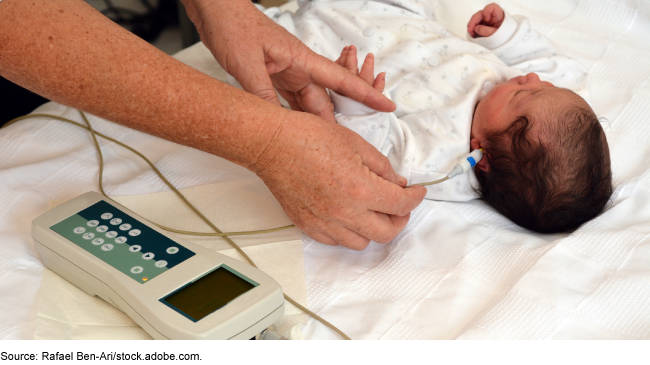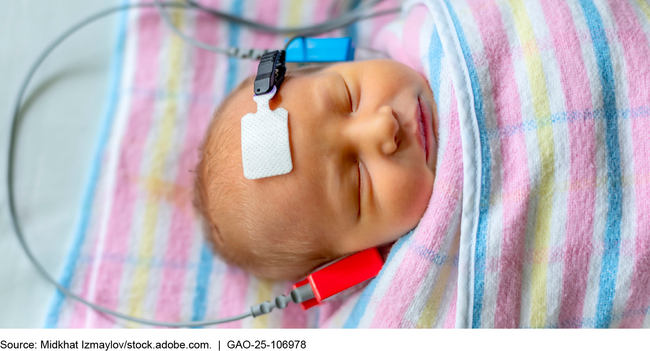Hearing Detection and Intervention: Program Connects Deaf or Hard of Hearing Infants and Children to Services, but Actions Needed to Improve Access [Reissued with revisions on Jan. 29, 2025]
Fast Facts
Thousands of infants are diagnosed as deaf or hard of hearing each year. The Department of Health and Human Services has a program that tracks infants' screening for and diagnosis of hearing loss. The program connects families with early intervention services to help prevent developmental delays.
HHS required states to submit diversity and inclusion plans that target underserved populations to address disparities in access to these services. But HHS hasn't asked states to set goals for or report on their progress with addressing disparities.
We recommended doing so to help ensure infants in underserved communities get the care they need.

Reissued with update to PDF on Jan. 29, 2025. Revised January 29, 2025 to correct a page in the PDF that was published out of order.
Highlights
What GAO Found
The Early Hearing Detection and Intervention (EHDI) program, administered by the Department of Health and Human Services (HHS), tracks the screening and diagnosis of infants for hearing loss and refers them for appropriate intervention services. Within HHS, the Health Resources and Services Administration (HRSA) uses data the Centers for Disease Control and Prevention (CDC) collects to measure EHDI program performance. HRSA and CDC have adopted age-defined care standards, known as the 1-3-6 benchmarks, to measure program performance on a national level. According to the 1-3-6 benchmarks, all infants should be screened for hearing loss before 1 month of age, and those that do not pass the screening should see a specialist to diagnose any hearing loss, as well as the cause, before 3 months of age. By 6 months of age, infants who are identified as deaf or hard of hearing should be enrolled in early intervention services for support in developing communication skills.
Hearing Screening of a Newborn Infant

Starting with 2021 data, CDC and HRSA agreed to change the measure the agencies use to assess state EHDI program progress against the 1-3-6 benchmarks. Previously, HRSA used a measure that did not count all infants who were eligible for follow-up care. For example, infants would not have been counted if their families could not be contacted by the state EHDI program to confirm whether the infants received follow-up care. HRSA plans to use a different performance measure to assess state progress starting with the 2024-2029 grant cycle that includes all infants with possible hearing loss as they progress through diagnostic and intervention services, according to HRSA officials. Officials from both agencies told GAO they are aware that the new measure will show a lower percentage of infants receiving timely access to services, but they agree it is a more accurate way to measure such access.
HRSA and CDC have taken steps to help address state challenges meeting EHDI benchmarks. For example, a 2023 program-wide survey and interviews with five of the six states GAO selected have found that shortages in experienced pediatric audiologists pose a challenge to improving access to timely diagnosis. HHS has taken steps to help states address this challenge by directing its technical assistance centers to focus on promising practices, such as the use of telehealth services, to overcome provider shortages.
In fiscal year 2024, HRSA set a new program requirement for state EHDI programs to measure language acquisition outcomes—that is, developing the comprehension and use of language. To help states begin collecting and measuring language acquisition outcomes, HHS agencies have taken actions such as conducting a pilot program and providing additional funding to strengthen state infrastructure to collect outcomes information. HHS also has efforts underway to address states’ reported challenges, such as providing technical assistance to increase states’ capacity for data collection.
HHS agencies took several actions to improve the EHDI program’s ability to identify and address disparities in access to services for children who are deaf or hard of hearing. HRSA required state EHDI programs to submit diversity and inclusion plans in 2021 to identify and address disparities in EHDI service access—differences in availability of services between groups defined by characteristics such as ethnicity or economic resources. However, GAO found that HRSA is unable to determine whether individual state EHDI programs’ efforts have been successful in addressing disparities in access because HRSA did not require states to set performance goals as part of their diversity and inclusion plans.
Further, GAO found that HRSA did not assess the results of the plans to understand how the plans might be updated or used to better address disparities in access in the 2024-2029 funding cycle. With a requirement in place for state EHDI programs to set and report on performance goals, states can demonstrate their progress in addressing access disparities for their identified underserved populations. In addition, HRSA’s assessment of states’ progress can inform future plans to support state EHDI programs. Doing so would better ensure children in underserved populations receive the care they need.
State EHDI programs have a variety of ongoing efforts to meet HRSA’s requirement to support families with a child who has hearing loss. Those efforts include: (1) parent-to-parent support through specially-trained parent guides who have a child who is deaf or hard of hearing; (2) adult deaf mentors who can help parents better understand what their child’s life might be like as a deaf or hard of hearing person; and (3) automatic referral processes to connect families with newly-diagnosed children to family support services to eliminate barriers to participation.
Why GAO Did This Study
About one in every 500 infants is identified as deaf or hard of hearing. Receiving early intervention services can help children meet speech, language, social, and emotional development milestones. For example, with appropriate services, children can develop the comprehension and use of language, known as language acquisition. HRSA provides grants to 59 states and territories (states) to support their data tracking and referral efforts. For the current grant cycle, HRSA awarded $235,000 per year to each state. In addition, HRSA has provided additional funding through competitive grant opportunities to state EHDI programs for targeted purposes.
The Early Hearing Detection and Intervention Act of 2022 includes a provision for GAO to review the EHDI program. This report (1) describes how HRSA measures EHDI program performance; (2) describes HRSA and CDC efforts to address state programs' reported challenges meeting EHDI benchmarks; (3) describes what HRSA and CDC have done to support state efforts to improve language acquisition and any challenges states may face in improving language acquisition; (4) examines HHS agencies' actions to identify and address disparities in EHDI program access; and (5) describes HRSA's efforts to help ensure support is available to parents of children with a hearing loss diagnosis.
To do this work, GAO analyzed HHS program documentation and relevant data from 2008 (the first year almost all states reported the same data since the creation of the program in 2000) to 2021 (most currently available at the time of GAO's review).
GAO also interviewed HHS officials and six state EHDI program grantees, selected to vary by factors such as geography and whether they received additional funding to support enhanced data collection. The six selected states were Alaska, Connecticut, Georgia, Minnesota, Ohio, and Puerto Rico.
GAO also reviewed documentation and interviewed officials from the Department of Education (Education) on their interactions with the EHDI program and data-sharing at the state level between state EHDI program offices and Education-funded offices that administer early intervention programs.
GAO reviewed diversity and inclusion plans from all 59 states' EHDI program offices. In addition to interviews with the four technical assistance centers HRSA funded in the last two funding cycles, GAO also interviewed three selected advocacy organizations. These organizations were the National Association of the Deaf, the Alexander Graham Bell Association for the Deaf and Hard of Hearing, and the American Society for Deaf Children.
Reissued with revisions on Jan. 29, 2025
Reissued with update to PDF on Jan. 29, 2025. Revised January 29, 2025 to correct a page in the PDF that was published out of order.Recommendations
GAO is making two recommendations to HRSA: (1) require state EHDI programs to set performance goals that can be used to measure progress in addressing any identified disparities in access for underserved populations; and (2) assess the results of state EHDI programs' access disparities performance and use it to inform future plans. HHS agreed with these recommendations.
Recommendations for Executive Action
| Agency Affected | Recommendation | Status |
|---|---|---|
| Health Resources and Services Administration | The HRSA Administrator should require state EHDI programs to set performance goals that can be used to measure progress in addressing any identified disparities in access for underserved populations and regularly report that progress to HRSA. (Recommendation 1) |
HRSA agreed with this recommendation. In June 2025, HRSA reported that it continues to review this recommendation and monitor broader policy directives that may impact its implementation. HRSA officials said they will continue to provide updates to GAO, as appropriate.
|
| Health Resources and Services Administration | The HRSA Administrator should assess the results of the state EHDI programs' access disparities performance and use the results to inform future plans for addressing access disparities. (Recommendation 2) |
HRSA agreed with this recommendation. In June 2025, HRSA reported that it continues to review this recommendation and monitor broader policy directives that may impact its implementation. HRSA officials said they will continue to provide updates to GAO, as appropriate.
|
